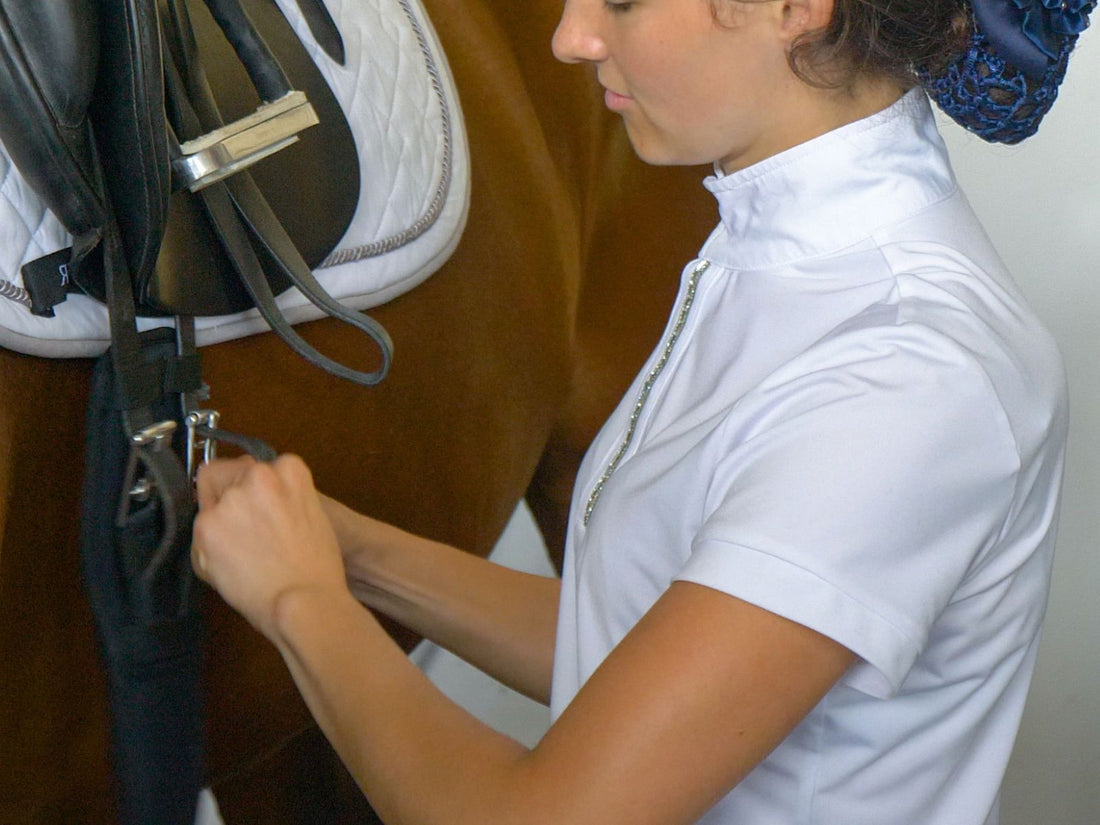
How to Measure, Size, and Fit a Dressage Girth
Michelle DrumDressage is all about your horse achieving precise, controlled movements through subtle aids and commands. A dressage girth secures your saddle in place, ensuring your horse’s freedom of movement and allowing you to stay balanced while communicating with your equine partner. In this guide, we’ll look in-depth at dressage girths, how they should fit, and how to measure them so you can select the right girth for your horse.
What is a dressage girth?
A dressage girth is a strap or band that fastens your saddle to your horse’s body. It is typically made of leather or synthetic materials and wider than traditional girths used in other equestrian disciplines. The extra width of the dressage girth helps distribute pressure more evenly over your horse’s barrel, reducing the risk of discomfort or chafing.
Dressage girths often have additional features, like elastic inserts of contoured shapes, to help with saddle stability and allow for better freedom of movement. The choice of girth size and type can vary depending on your horse’s conformation, the saddle used, and your preferences.
How should a dressage girth fit?
The girth should be fastened just behind your horse’s front legs and a hand’s width behind the elbow. You should cinch the girth slightly above elbow level, tight enough to secure the saddle while leaving enough slack to fit two fingers between the girth and saddle pad. Any tighter could cause pinching and discomfort.

In dressage riding, a properly fitted girth directly influences your horse’s comfort and, as a result, impacts their ability to perform the intricate, precise movements required.
It’s important to measure your horse’s girth accurately before selecting a dressage girth size. Sizing corresponds to your horse’s actual girth measurement. If the measurement falls between two sizes, choose the larger size for a comfortable fit. Properly sized tack is essential for your horse’s comfort and safety during dressage or any other riding discipline.
How to measure your horse’s girth
Measuring your horse’s girth is the first step in selecting the right girth size for your horse. To measure a horse’s girth, follow these steps.
1. Gather the necessary equipment
You’ll need a soft measuring tape or a piece of string and a regular tape measure, as well as a friend to hold the measuring tape or string in place.
2. Position your horse
Secure your horse in a safe and comfortable area, like a grooming stall or a quiet spot in the barn. Your horse should be standing on level ground with all four feet planted squarely beneath them.
3. Locate the girth area

The girth area is the part of your horse’s body just behind the front legs and the elbow.
4. Measure the girth

If you’re using a soft measuring tape, gently place it around your horse’s girth area, ensuring it is snug but not overly tight. The tape should lie flat against your horse’s body.
If you’re using a string, loop it around the girth area, mark the point where it meets the other end, and then measure the string’s length with a regular tape measure.
Pro tip: If you don’t have a friend with you to hold the measuring tap in place, use a piece of duct tape!

5. Record the measurement

Note the measurement in inches (you can convert to centimeters later if needed).
6. Choose the appropriate girth size

Use your girth measurement to find the proper size for your horse. Keep in mind that girth sizes are typically even numbers, such as 24, 26, 28 inches, etc. If your horse’s girth measurement falls between two sizes, choose the larger size for a comfortable fit.
Dressage girth sizing
Dressage girth sizes are usually available in even numbers and measured in inches or centimeters. Here are some of the most common dressage girth measurements.
| Horse Height | Inches | Centimeters |
| 13-14 HH | 18” | 45 cm |
| 13-14 HH | 20” | 50 cm |
| 14-15 HH | 22” | 55 cm |
| 14-15 HH | 24” | 60 cm |
| 15-16 HH | 26” | 65 cm |
| 16-17 HH | 28” | 70 cm |
| 17+ HH | 30” | 75 cm |
| 17+ HH | 32” | 80 cm |
| 17+ HH | 34” | 85 cm |
| 17+ HH | 36” | 90 cm |
How to find the proper girth placement
Proper girth placement and tension keep your horse comfortable. If the girth is too loose, your saddle can slip, causing a safety hazard for you as a rider. If it’s too tight, it can cause pain, restrict movement, and lead to soreness for your horse. Occasionally, checking and adjusting the girth as needed throughout your ride is a good practice.
Here are a few other best practices when determining the proper girth placement for your horse.
Proper saddle position
Make sure your dressage saddle is correctly positioned on your horse’s back before attaching the girth. Your saddle should sit level and centered on your horse’s back, with the pommel and cantle at the appropriate heights.
Learn more: How to Measure for an English Saddle
Even tension
When attaching the girth, ensure the tension is even on both sides. Uneven girth tension can cause your saddle to shift, leading to discomfort and potential saddle sores. You can check the tension by tugging gently on each side of the girth to make sure it feels even.
Secure, but not overly tight fit
Fasten the girth snugly but not excessively tight. The girth should be tight enough to keep your saddle in place while you ride but not so tight that it restricts your horse’s movement or causes discomfort. A rule of thumb is to make sure at least two fingers comfortably fit between the girth and your horse’s body.
Pressure points
After securing the girth, check for any pinching or wrinkles in your horse’s skin or hair. If you see any, this may indicate that the girth is too tight or not correctly positioned. Adjust as needed.
Periodic monitoring
As you ride, periodically check the girth to ensure it remains secure and hasn’t become too loose. Girths can sometimes loosen during a ride, especially if your horse’s sweat causes your saddle pad to shift.
Reassessment after warm-up
After your horse has warmed up and the muscles have relaxed, it’s a good idea to check the girth tension and adjust it if necessary. Horses’ girth areas can change slightly as they warm up and their muscles expand.
The right dressage girth can level up your performance and give your horse that extra bit of comfort he needs. Use this guide to help you find the best fit for your dressage girth, but don’t hesitate to reach out to the Farm House Tack team with any questions! We’ve been doing this a long time, and we know a thing or two about horse tack and riding equipment.
Don’t forget the rest of your dressage tack!
You might also like:

1 comment
Very helpful, thank you